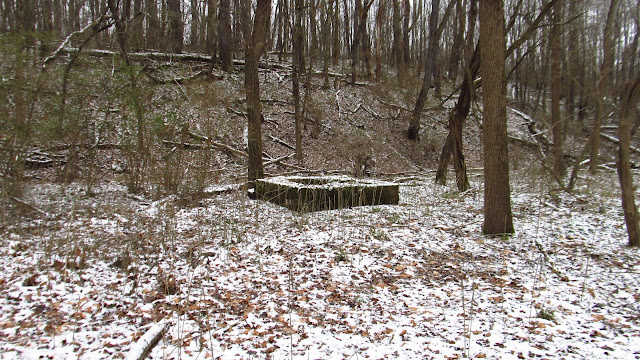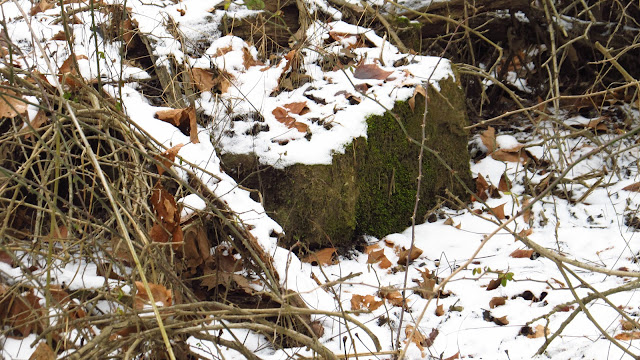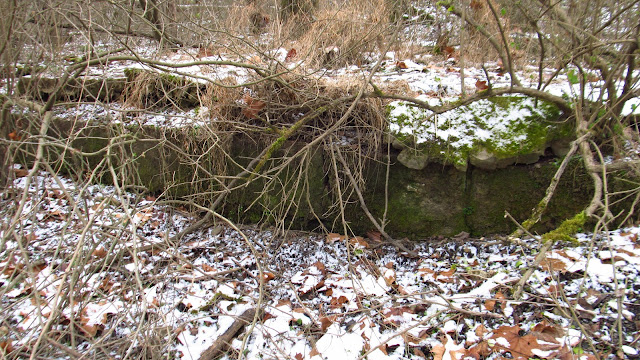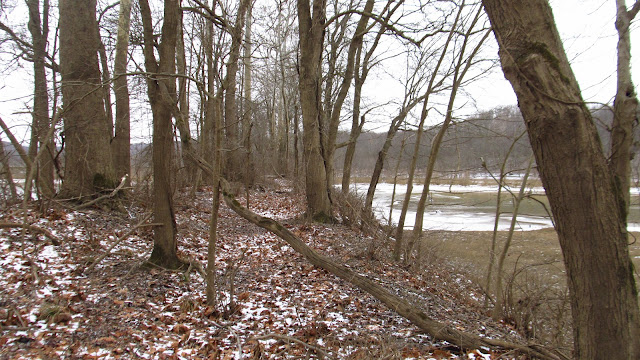On Saturday, I headed back out to Livermore to dig around a little more and follow the 1863 alignment of the Western Pennsylvania Railroad down to the old bridge approach further downriver. It was something I'd been wanting to do for a few years now, and I decided to keep it local since nobody can predict weather in Pittsburgh anymore. Spoiler alert: it didn't snow.
Anyway, as we know, there's no indication of the town of Livermore ever existing as far as foundations and structural remains. The railroad alignment sat much higher above the ground and hasn't been subjected to the constant bombardment of floodwaters that buried any trace of the town deep in the mud of the floodplain. Prior to 1907, when the large stone arch bridges were constructed, the railroad largely followed the course of the river, instead of bridging its way across it.
As I said before, this alignment didn't become active until 1863 when the Western Pennsylvania Railroad opened it. However, it was mapped out, and some of the grading was done several years earlier. In 1853, the North-Western Railroad Company was created to build a line from Allegheny Portage to New Castle. The purpose of the railroad was to build a western route bypassing Pittsburgh and connecting with the Cleveland and Mahoning Railroad at New Castle. Surveying and grading from Blairsville to Butler began in 1854, no track was laid at this time. The North-Western Railroad went belly up due to the panic of 1857. The Western Pennsylvania Railroad Company was formed in 1859 after purchasing the North-Western ROW in foreclosure. Trains started running from Blairsville to Saltsburg in the Fall of 1863. So some of this grading possibly dates back to 1854. There is an enormous cut just above Livermore, and the grade itself still remains very prominent and easy to follow.
 |
Getting onto to the grade was very easy. It's directly behind where Livermore station used to sit, right along the trail. |
 |
Livermore Station. Even in this photo, you can see the old grade behind it. |
 |
Looking down into the former Livermore town site. |
 |
Maybe this what part of a tunnel heading under the railroad grade? The other side did not contribute to that theory, but the terrain has been changed so many times over the years. |
 |
Nice Star arch brick just sitting here. These are typically seen at coke oven sites. No idea why it's here. |
 |
The 1863 grade. |
 |
Immediately it comes to this old foundation. The old maps really don't suggest much in this area other than the original railroad station house. This may have been part of that. |
 |
This 1876 map of Livermore clearly shows the "R.R. Station Ho". |
 |
A closeup of that foundation. |
 |
Above it was some more cut stone. Perhaps it was a siding for the old station. |
 |
A little further up were these old piers. |
 |
Up on the grade again. |
 |
Certainly the railroad grade. The cut from earlier is down on the right. |
 |
A very odd growing tree. |
 |
Left of the railroad grade. I finally got to see the other side of the culvert that I found from the river a couple years ago. |
 |
It's still working and flowing. |
 |
This is the other side of it and can be found on a previous post by clicking here. |
 |
Approaching the huge cut. |
 |
An old railroad spike, in an old railroad tie, that has been sitting here since at least 1907. |
 |
This cut is flooded. It wasn't cold enough to be frozen completely through so I had to pick my best slushy spots. My feet remained dry and I was successful in my mission. |
 |
I did climb the cut on the right before I got to the end. This was too flooded. |
 |
Coming out of the cut I noticed a huge foundation on the left. The 1939 aerial shows a farm here, so I'm assuming this was a barn foundation. |
 |
The farm is toward the center of the 1939 aerial. The old grade is easily identifiable coming up west of Livermore. The 1907 alignment, and the current West Penn Trail, is at the bottom of the photo. |
 |
Closeup of the old foundation. |
 |
Toward the center of this photo is a concrete trough that ran the length of the foundation. Further making me believe this was a barn. |
 |
Walking out of the farm area. Obvious grade on the right. |
 |
Back on top of the grade. |
 |
This is looking off the grade and bridge approach at the second stone arch bridge east of Bow Ridge. |
 |
Coming up to the top of the old bridge approach. |
 |
Looking across at the other abutment. Second stone arch bridge to the left. |
 |
The top of the bridge approach. I've always wanted to be up here! |
 |
Opposite bridge abutment with the old pad for one of the piers at the bottom of the photo. |
 |
These pier pads are not always underwater. I have paddled up alongside of them in the summer. |
 |
Side of the bridge approach. Again, other angles of this can be seen here. |
 |
Remains of long gone trees. |
 |
Walking back. This time I walked over the top of the cut. This and the following photos are looking down into it. It's hard to tell how deep this cut actually is without seeing it firsthand. |
 |
Back in Livermore. The Livermore Bridge is in the background and the old canal basin is in the foreground. |
 |
The old town site of Livermore. |
 |
The old Livermore/Fillmore Bridge. |
 |
A couple more photos of the Livermore side abutment. |
 |
Looking across at the Fillmore side. |
 |
Looking up along the former Bridge Street in Livermore. |





























My cousin and I walked this same area last summer (and each walked away with ticks!) and saw much of what you've memorialized here. As usual Mike, you've done a great job.
ReplyDeleteThanks Walt!
DeleteNice Mike. I made that trek in the spring of 2012 or 13. I too always wanted to get out on that pier. The spike you found is older than 1907 keep in mind. I have one as well. The way Main Street/982 crossed the 1907 grade was a small bridge going over the cut. It was there years after the 1953 grade/Dam build. There used to be a picture of it in a placard when the West Penn Trail was created. I can remember driving my 1986 Ford LTD before the trail was started. And i'm only 36. Crazy. I approached the old grade by walking up the hillside to the left of the 1907 station spot, but had to shimmy down into the muddy cut with our bearded collie. She wasn't too happy. I commented on your paddle through the canal years ago. I was the one who disagreed the one section was the canal, but the tailrace from the westbound lock before Livermore instead. Congrats again from a former Delmontian Born and Raised! RIP Carney's.
ReplyDeleteHey! It's always good to hear from a Delmontian! I remember driving back on that grade as well. Long time ago.
Delete